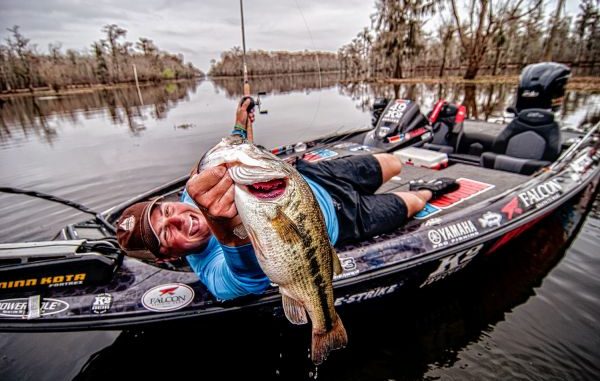
Bassmaster Elite Series pro Cliff Crochet gives pointers to load the boat
Pierre Part’s Cliff Crochet spent all last week either practicing for or competing in the 2014 Bassmaster Classic held on Alabama’s Lake Guntersville.
And all he could think about after the final-day weigh-in was pitching to cypress trees in his home waters within the Atchafalaya Basin.
So after a single day of rest — which included the six-hour drive home — Crochet launched out of Belle River Landing Tuesday morning and headed into the thick of the Basin.
It didn’t take long for the angler known on the pro circuit at “The Cajun Baby” to put his first bass, a chunky Kentucky, in the boat.
About 45 minutes later, he set the hook on a 4-pound largemouth.
All in one of the main bayous north of the landing.
“I’d rather fish the main bayous because they’re the main vein,” Crochet said. “They’re going to be in there.”
That even goes for the spawn, which he said is on the verge of beginning in earnest.
“There’s fish that spawn in those main bayous,” he said.
Of course, he admitted that many of the fish will be moving into the backs of dead-end canals throughout the Basin.
The key will be to find the right water — whether you choose to work main bayous or dead-ends.
“Clear water or clean water,” Crochet said. “Either one will work.”
But if he finds some clean, stained water, Crochet said it’s game on.
“In fact, the stained waster can be better because sometimes in that clear water the fish see too much,” he said. “That stained water gives you some kind of camouflage.”
He proved that earlier when working a Rogue off a shallow cypress tree in the back of a canal that was filled with super-clear water: A bass followed the bait away from the tree, but spooked when it and the lure got within 5 feet of the boat.
In the main bayous, Crocket said he likes to find where water is pushing from two directions because often that means the best water will be concentrated.
“I’m looking for where the good water is compressed,” he said. “You might have muddy water coming from one bayou and clear water coming from another bayou, and there will be somewhere where the good water is pushed; it’s compressed.”
It will be in that limited stretch of water that is cleaner than the muddy water but more-stained than the clear water that he will focus.
Another key no matter where you concentrate is water movement, or rather a lack thereof.
“The only thing I try to do is stay out of the current,” Crochet said.
Of course, because the Basin is a riverine system that also is impacted to some degree by tidal flow, there will be some amount of flow.
“I just want to find the least current I can,” he said.
The water on this day reached 65 degrees by the late afternoon, and Crochet said that means bedding fish should become the norm for the next couple of months.
“When it happens, there’s going to be no such thing as too shallow,” Crochet said. “If there’s enough water to wet them, they’ll be there.”
Jigs, plastics — well, pretty much anything could work. Mostly because the fish aren’t really eating.
And that means actually hooking these fish can be challenging.
“These bed fish sometimes are just moving the bait,” Crochet said. “If you gig down on them and hit them hard, you’ll pull the bait away from them.
“But if you just lean into your hook set, you’ll hook them.”
Missed hook sets will be common, but Crochet said the great thing about the spawn is that a fish on a bed will usually head right back to the bed even if a lure is snatched out of its jaws.
“They’ll be back, even if it takes a few minutes,” Crochet said. “That’s worth sitting five or 10 minutes and waiting for it to get back on the bed.”
While some fish might already have spawned, the crazy weather that has reigned will play into anglers’ hands.
“Last year it was so warm that fish were spawning here and there whenever it warmed up,” Crochet said. “This year, when it breaks loose, I think it’s going to be everywhere because it’s been cold.”
He predicted the fish would spawn in waves for the next three months.
And that means there will always be some fish either preparing to move shallow or moving off the beds — which means even if you don’t find success with bedding fish you have an alternative.
“If you fish all the dead-ends and it’s not on, back out of the dead-ends — maybe the front third instead of the back third — and fish,” Crochet said. “And back off the shallows and fish a little deeper.”